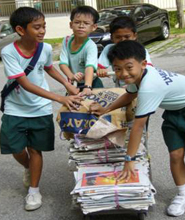Why Singapore’s English Teachers Should Embrace Singlish, Not Fight It
Is it time for Singaporean educators to embrace Singlish as a legitimate learning tool? What the Research […]
Read More
Science education goes beyond teaching and learning. It’s also about understanding what is taught, and then applying it. As teachers, we hope that what we teach our students will be useful to them, even in their daily lives.
We teach and we test, and hope that our students learn the lessons we seek to impart to them. But what are they really learning?
If an understanding of scientific knowledge is the aim, then many of us have been successful. But the application of this knowledge is also a key goal of the science curriculum (Ministry of Education, 2008).
Assistant Professor Kim Mijung from the National Institute of Education says that science education can provide students “with a means of linking what they learn in science classrooms and their everyday world outside” (Kim & Roth, 2008, p. 516).
And science education gives us a unique opportunity to help our students make this important link. Through the science classroom, we are able to “address the importance of the practice [emphasis added] of scientific knowledge in real life situations” (Kim & Roth, 2008, p. 521).
Lessons on science and the environment is one area in which we can show our students how to practise science. But “environmental knowledge alone is not sufficient to bring about pro-environmental behavioural changes” (Kim & Roth, 2008, p. 521).
How can we make these lessons come alive to students?
In recent years, environmental issues have become a hot topic in the science classroom and in society. One Singapore primary school is providing its students with opportunities to think critically about and act on their knowledge of caring for the environment.
Zhenghua Primary School has implemented a “Care for the Environment” programme since 2001. They want their pupils to become good and useful citizens with a strong sense of social responsibility. This is expressed in caring for the environment.
Says Mdm Lim Min Chern, Head of the Science Department, “When we show the young how easy it is to care for the environment, through simple yet concrete actions, we can all make environmental consciousness a way of life.”
To this end, Zhenghua Primary has launched several initiatives to promote environmental consciousness. These initiatives align with what the pupils are learning about the environment in the Science and Life Science curriculum, which is also in line with the Singapore Green Plan 2012.
The school believes that the pupils should take an active ownership when it comes to caring for the environment. They have adopted a multi-pronged approach to raise awareness (Minds On), encourage participation (Hearts On) and involvement (Hands On).
Pupil volunteers are appointed as Environmental Champions (ECs) and Green Ambassadors (GAs) of the school and classes, respectively. They serve as role models to other pupils in environmental activities like:
The teachers are also actively involved in facilitating and modelling this environmental consciousness.
Min Chern believes that these programmes help the pupils to link what they are learning in the classroom to what is going on in the world around them. And so far, the response has been positive.
 To ascertain how successful their efforts at cultivating environmental consciousness have been, the school engaged the help of Mijung.
To ascertain how successful their efforts at cultivating environmental consciousness have been, the school engaged the help of Mijung.
Mijung has been involved in a comparative study of young people’s understanding of environment issues across three countries. In her survey of the pupils at Zhenghua Primary, the ECs and GAs (referred to as the Eco-group) were compared with the general school population (the non-Eco-group).
The survey measured two dimensions of environmental consciousness: belief and willingness to act. Based on the survey data, Mijung found that those who are actively involved in environmental activities (the Eco-group) showed a significant difference in their beliefs and willingness to act on their beliefs.
The Eco-group was keen to recycle, to plant more trees, and to be energy efficient, among other things. And they would readily recommend that others make an effort to conserve the environment as well.
Mijung’s findings matched the findings from a survey by the National Environment Agency on the “Knowledge, Attitude, Beliefs and Practices” of Zhenghua’s pupils with regard to issues on climate change.
The survey findings confirm that the school is on the right track. By raising awareness of environmental issues and enabling the pupils to act on this knowledge, their attitudes and behaviours have become “greener”.
Learning science can be more than just gaining knowledge. It can be used by students to improve the environment and continue in responsible efforts to care for their society.
The pupils at Zhenghua Primary are clearly conscious of this. Says Min Chern, “It is heartening to see and to know that we had somehow helped the pupils appreciate the environment more.”
References
Kim, M., & Roth, W.-M. (2008). Rethinking the ethics of scientific knowledge: A case study of teaching the environment in science classrooms. Asia Pacific Education Review, 9(4), 516-528.
Ministry of Education. (2008). 2008 Science (Primary) syllabus. Retrieved from the MOE website:
https://www.moe.gov.sg/education/syllabuses/sciences/files/science-primary-2008.pdf